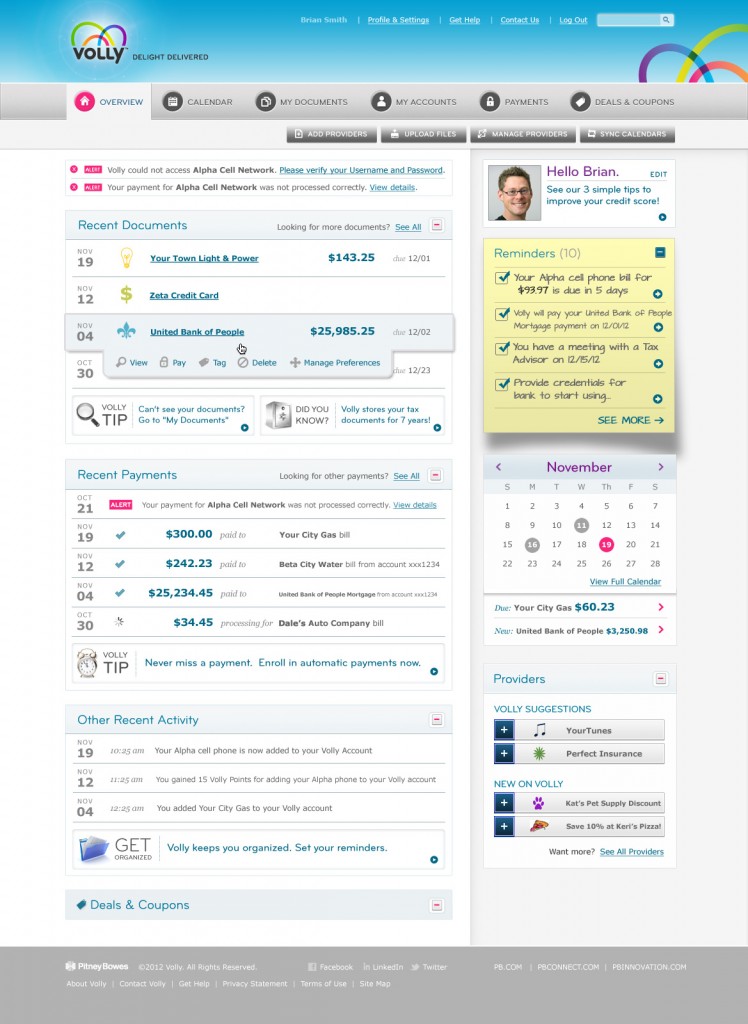Say “Pitney Bowes” (PB) to the man or the lady in the street in a word association test, and the response probably will be “postage meters.” That’s fine with this iconic Fortune 500 company, which has been making the gadgets for more than 90 years and is far and away the world’s largest seller of systems for imprinting postage on mailing pieces.
But, because of displacement by the Internet, the uncertain outlook for the U.S. Postal Service, and other factors shrinking the volume of what postage meters exist to process, the mailstream isn’t the same as it used to be—and neither is Pitney Bowes. Since 2009, the company has been undergoing a strategic transformation aimed at making it less centered upon physical mail and more diversified as a provider of alternative digital delivery services.
Pitney Bowes offered a progress report on its transformation at Global Innovation Day, an event held recently at its world headquarters in Stamford, CT. Originally an internal open house for employees, Global Innovation Day was broadened this year to include briefings for journalists and analysts. The program for the media featured updates on Pitney Bowes solutions for cloud-based mail management, do-it-yourself marketing campaigns with QR codes, and e-commerce for international shippers.
Also on the agenda was Volly, an integrated content delivery and bill payment service that Pitney Bowes first unveiled last year and is readying for consumer rollout at the end of 2012.
Pitney Bowes serves enterprise customers as well as small and medium businesses (SMB), deriving its revenue in equal shares from the two segments. Most of what was presented to the media at Global Innovation Day is targeted at the SMB market as pbSmart™, a suite of cloud-based solutions designed to help small and medium businesses market themselves with the same sophistication as larger companies. Pitney Bowes says that about 30,000 of its customers are now using pbSmart solutions.
The general objective, said Neil Rader, vice president and general manager for SMB, is to migrate the technologies downstream to a point where it becomes easy and desirable for these customers to use them. If embracing digital solutions causes SMB marketers to become less dependent on postage meters and other conventional mailing equipment—as some of the products shown at Global Innovation Day are designed to do—that outcome will not be at odds with the new identity that Pitney Bowes is striving for.
“We are a communications management company,” Rader said, adding that Pitney Bowes has solutions to support the full mix of digital and physical channels its SMB customers typically use.
Road warriors, low-volume mailers, and others who need stamps but not stamp-imprinting equipment can have one without the other by signing up for pbSmartPostage™. The service, described by Pitney Bowes as the first web-based shipping and mailing solution, lets users with an Internet connection output stamps and shipping labels from any printer, wherever they happen to be. Besides eliminating the need for postage meters and trips to the post office, pbSmartPostage also schedules USPS pickups, tracks package delivery, and generate usage reports.
Under monthly pricing plans that are not volume-based, users can replenish their postage accounts online with a credit card. Subscribers also have access to USPS discounts that can save them, according to Pitney Bowes, an average of 8% of their postage costs.
Some of the same functions are built into pbWebConnect™, a product launching this month. pbWebConnect is for business mailers who continue to rely on postage meters but who also want the option of managing their mailing activity online. pbWebConnect makes this possible with the K700 mailstation, a Pitney Bowes meter offering a direct Internet link to the company’s data center.
Once connected, the meter can be accessed remotely through a Web browser, and many of its common functions can be automated—for example, postage account refills, postal rate updates, and alerts for high postage (i.e., over-stamping). Trackability, report generation, and USPS discounts are additional benefits of pbWebConnect.
Like any other vendor of communications management technology, Pitney Bowes appreciates the marketing potential of QR codes. It also acknowledges that QR codes have been slow to catch on at the SMB level, mostly because small businesses don’t fully understand what they can do with 2D barcodes once they’ve generated them. Hence the development of pbSmart™ Codes, introduced last October as an all-in-one solution for building integrated marketing campaigns around customizable QR codes.
The service—entirely cloud-based, and available to try free of charge—builds an end-to-end campaign from code generation and messaging to back-end tracking and analysis. The landing pages are mobile web sites that subscribers can create and modify from templates. Logo-bearing QR codes, encrypting links to coupons, discount offers, and other marketing inducements, can be applied to printed media and to high-visibility promotional items such as mugs and T-shirts. (Pitney Bowes can supply these goods through its relationship with Zazzle, an online retailer of customized consumer products.)
At the back end, pbSmart Codes presents response rates in real time, collects the results of mobile customer surveys, compiles e-mail leads, and saves the data for reference in future campaigns. Pitney Bowes also supplies ScanShot, a multifunction mobile bar code reader available from online app stores.
At Global Innovation Day, the company also promoted its suite of global e-commerce solutions, aimed primarily at U.S. retailers wishing to take the surprises out of fulfilling orders across international borders. Import duties, foreign postage, and other transactions for global shippers are addressed by these solutions.
Easily the most ambitious project in the transformation of Pitney Bowes is Volly. Its objective is to replicate physical mailboxes with virtual ones—not because the company foresees the disappearance of conventional mail delivery, but because it is convinced that consumers also want a digital equivalent that serves the same purpose.
Pitney Bowes says that consumers who can be persuaded to sign up for Volly will find it a friendly and fully secure workspace where, free of charge, they can view and pay bills, organize and archive records, clip coupons, and order things they want—just as they do through the medium of paper mail, but now, minus the clutter and the inconvenience of handling paper.
Within the Volly environment, says the company, a consumer can see and manage all of her opt-in retail relationships in one place. She’s no longer obliged to visit separate Web sites, memorize a corresponding number of passwords, or endure any of the other repetitive drudgeries of uncoordinated online shopping.
Direct-mailing retailers that choose to connect with their customers through Volly are promised benefits of their own, chief among them the opportunity to integrate a paperless channel with their conventional mailstreams. They can continue to send physical mail to customers who prefer paper, but in Volly, they also have a straight path to consumers who are growing comfortable with the idea of shopping with smartphones, tablets, and other e-devices.
When Pitney Bowes first announced Volly in January of 2011, the service did not yet have a critical mass of participation by retailers or consumers. The basic platform existed, but the next step was to build up its transactional capabilities by enlisting the support of third-party providers of billing and mailing services to businesses that sell retail goods and other products to consumers.
With about 50 such partnerships in place, Pitney Bowes believes that Volly now can achieve the density of digital mailing it will need in order to be successful. Using its employees as focus groups, the company also has tested and extensively modified the elements of Volly that consumers will see.
The result is a Volly that finally is ready for general launch in the U.S., which Pitney Bowes says it intends to do in the fourth quarter of this year. B2C partners have come aboard as well, although the company declined to identify them or to say how many have signed on. These brand owners are expected to join Pitney Bowes in promoting Volly to consumers at large.
Those who accept the invitation will be able to aggregate all of their bill-paying within the Volly portal, which Pitney Bowes promises to keep spam-free by permitting communications only from the accounts to which consumers have opted in. Calendars and to-do lists (see screen shot) will help them stay ahead of bills coming due and confirm payments that they have already made—a feature requested by the employee focus groups.
Participating businesses can use Volly to present coupons, catalog offers, and other promotions to consumers through branded landing pages. Fully implemented, the consumer-facing parts of Volly will serve as virtual transpromotional documents that combine billing information with targeted marketing communications as directed by the brand owners.
Reassuring consumers and retailers that they will be in driver’s seats has been a keynote of the project from the beginning. As the launch nears, said Bernie Gracy, vice president of business development for Volly, “we are setting a table between customers and brands that both can have control over.”
Among the first to dine at the table will be citizens and businesses in Australia, where Australia Post, the nation’s postal service, has announced that Volly will be the platform for the Digital Mailbox service it plans to launch later this year. A press release from Pitney Bowes says that the company will provide Australia Post with the software, technology and mailer-integration infrastructure to begin secure, digital delivery of content from business mailers in the Commonwealth.


